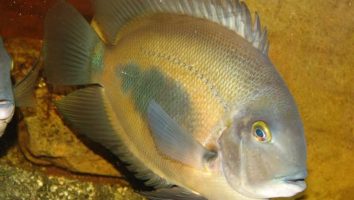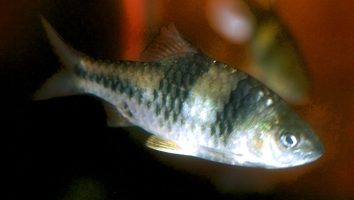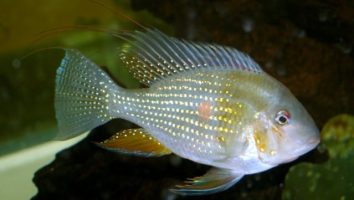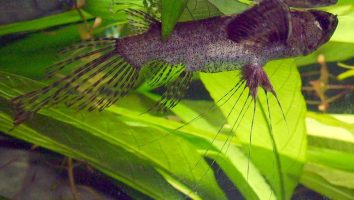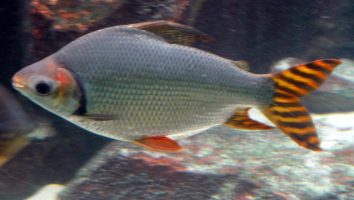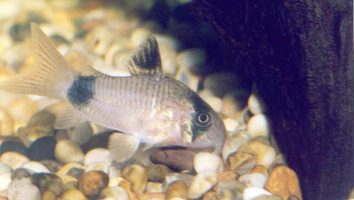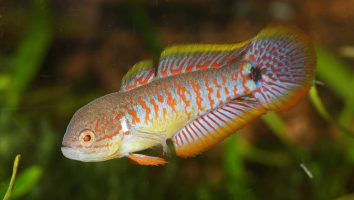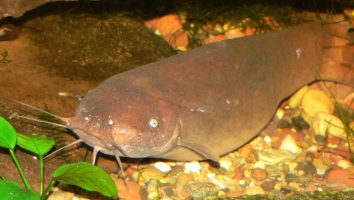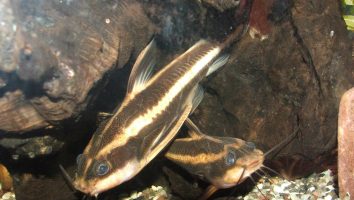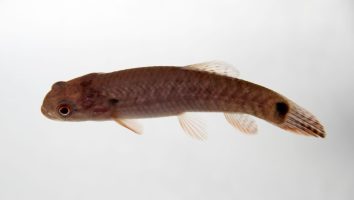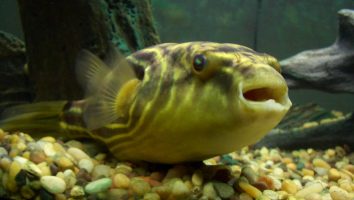The goldfish is a freshwater fish that is popular among beginners. They are relatively easy to care for and come in a variety of colors and sizes.
Goldfish are a type of carp and can live for up to 20 years if they are well-cared for.
This guide will teach you everything you need to know about goldfish care. You’ll learn about their diet, size, lifespan, and more!
Table of contents
Species overview
Goldfish (Carassius auratus) are a type of freshwater fish that are native to East Asia. They have a long history of being kept as pets, and their popularity is still going strong today.
There are many different types of goldfish, and they come in a wide range of colors and patterns. The most common goldfish colors are orange, white, and black.
Goldfish are generally very hardy fish, and they can live in a wide range of water conditions. However, they do prefer cooler water temperatures and will do best in an aquarium that is kept between 65 and 75 degrees Fahrenheit.
Goldfish are omnivorous, which means that they will eat both plants and animals. In the wild, their diet consists mostly of insects, small crustaceans, and plant matter. In the home aquarium, they can be fed a variety of foods, including pellets, flakes, and live foods.
Goldfish are very popular pets, and they are kept by aquarium enthusiasts all over the world. If you’re thinking about getting a goldfish, be sure to do your research and choose a type that will be well-suited to your home aquarium.
Appearance

The appearance of the Goldfish is what really sets it apart from other species of fish. These fish are very brightly colored and have a lot of different color variations. The most common colors are gold, orange, white, and black.
But, you can also find goldfish that are blue, red, brown, and even green!
These fish have a very distinctive shape that is very different from other fish. They have a long and thin body with a large head. The head is very round with a small mouth that is often turned down.
Their fins are also very different from other fish. The dorsal fin is very short and starts almost at the end of their body. Their anal fin is also very short and starts about halfway down their body. But, the caudal fin is very long and flows behind them.
Their pectoral fins are also very long and thin. Goldfish are unique in the fact that they are the only fish that have an adipose fin. This is a small fin that is located between their dorsal fin and caudal fin.
Lifespan
In captivity, goldfish have an average lifespan of 10 to 15 years. However, it’s not uncommon for goldfish to live up to 20 years, or even longer!
As with any animal, the lifespan of a goldfish is greatly impacted by the level of care they receive. Things like poor water quality, inadequate diet, and improper housing can all shorten their lifespan.
Size
The average goldfish size is around 4 to 6 inches. Some goldfish can grow to be as big as 12 inches or more, but this is quite rare. The size of your goldfish will depend on the species, as well as the quality of care it receives.
Tank
Tank Size
The recommended minimum tank size for goldfish is 20 gallons. This is assuming you’re only keeping one or two fish and that you’re not planning on keeping any other fish in the tank with them.
If you want to keep a school of goldfish or add other fish to the tank then you’ll need to increase the size of the tank accordingly. For every additional goldfish you want to add to the tank, you should add at least 5 to 10 gallons.
Water Parameters
Goldfish are a bit more finicky when it comes to water parameters. They like things a little cooler and a little more on the alkaline side.
You also need to be more careful about filtration and water changes. Goldfish are messy eaters and produce a lot of waste. That waste can quickly pollute the water and lead to serious health problems.
Frequent water changes and a high-quality filter will help keep the water clean and the goldfish healthy.
- Water temperature: 60 to 72 degrees Fahrenheit
- pH levels: 6.5 to 7.5
- Water hardness: 4 to 8 dGH
- Alkalinity Levels: 6-12 dKH
What To Put In Their Tank
When it comes to setting up the interior of an aquarium for goldfish there are a few things to consider.
The first is the size of your tank. Goldfish are known to grow quite large (some even reach lengths of over a foot!).
This means that you’ll need to provide them with a tank that can accommodate their size. A good rule of thumb is to get a tank that can hold at least 10 gallons of water per goldfish.
The second thing to consider is the type of substrate you use. Goldfish are known to be heavy diggers and can easily uproot plants.
We recommend using a gravel substrate instead of sand since it’s less likely to be disturbed. You can also go with a bare bottom tank if you’d prefer.
Another important consideration is the type of decorations you use. Goldfish are known to destroy soft plastic plants and decorations.
We recommend using hardier plants or non-plant decorations like rocks or driftwood. You can also use live plants if you’re careful about the types you choose (avoiding delicate root systems).
Finally, it’s important to provide goldfish with a place to hide. These fish are known to be skittish and easily stressed.
We recommend using a cave or piece of driftwood for this purpose. You can also use live plants to create a natural hiding spot.
Common Diseases
Goldfish are one of the most popular freshwater fish for a reason: they’re beautiful, hardy, and relatively low-maintenance. However, they’re not immune to disease and illness.
The most common disease that goldfish suffer from is ich. This is a parasite that manifests itself as white spots on the body of your fish. It’s very contagious and can quickly spread to other fish in your tank.
If you notice ich on your goldfish, the best course of action is to quarantine the affected fish and treat the entire tank. There are a number of different ways to treat ich, so consult your vet or do some research online to find the best method for your situation.
Another disease that goldfish are prone to is swim bladder disease. This is a condition that prevents your fish from being able to control their buoyancy. As a result, they may float to the surface or sink to the bottom of the tank.
There are a number of different causes of swim bladder disease, but the most common is constipation. This can be caused by a number of different things, such as a diet that’s too high in protein or a lack of fiber.
If you think your goldfish has swim bladder disease, the best course of action is to consult your vet. They will be able to diagnose the condition and recommend the best course of treatment.
Behavior & Temperament
Goldfish are one of the most popular pets in the world. They’re beautiful, unique-looking creatures that come in a variety of shapes and sizes. And, they’re relatively easy to take care of, which makes them a great option for first-time fish owners.
But, what about their temperament? Are goldfish aggressive?
The answer is… it depends.
Goldfish are generally peaceful fish. They’re not known for being aggressive or territorial. However, there are always exceptions to the rule. Some goldfish can be aggressive, especially if they don’t have enough space to swim around in.
Goldfish are also known to be nippy. They may nibble on the fins of other fish, which can cause irritation and even infection. If you have goldfish, it’s best to keep them in a tank with other goldfish. That way, they can’t bother other fish and will be less likely to get nipped themselves.
Tank Mates
Goldfish are a bit more difficult to pair with other fish because they have very specific needs. They come from cool waters and prefer a slower water flow.
They also produce a ton of waste, which can make the water quality in their tank deteriorate quickly.
For these reasons, it’s best to pair goldfish with other species that can handle similar conditions.
Some good goldfish tank mates include:
-
- Weather Loach
- Dojo Loach
- Bristlenose Pleco
- Cherry Shrimp
- Ghost Shrimp
- Amano Shrimp
- Types of Goldfish
- Mystery Snail (not for ponds)
Breeding
Goldfish are pretty easy to breed if you have the right setup. You’ll need a pond that’s at least 50 gallons and has a good amount of plants. The water should be clean and at a comfortable temperature for goldfish (between 65 and 72 degrees Fahrenheit).
When ready, add two adult goldfish to the pond. Make sure that you have one male and one female. The male will have white spots on its gills called breeding tubercles. The female will be larger and have a more rounded belly.
Once the goldfish have acclimated to their new home, they’ll start to spawn. The female will lay her eggs in the plants. The male will then fertilize them.
You can remove the adults at this point or leave them in the pond. If you remove them, make sure to put them in a different tank. Otherwise, they’ll just eat the eggs!
The eggs will hatch in about a week. The fry will be very small, so you’ll need to feed them live foods. Baby brine shrimp or daphnia are good options.
As they grow, you can start to introduce other foods. Goldfish are omnivores, so they’ll eat just about anything. Give them a varied diet to ensure that they get all the nutrients they need.
Conclusion
Overall, we think goldfish are a great choice for beginner fish owners and experienced fishkeepers alike. They’re relatively easy to care for, come in a wide variety of colors and sizes, and are just plain fun to watch!
If you’re thinking about adding a goldfish or two to your tank, we say go for it! We think you’ll be glad you did.

